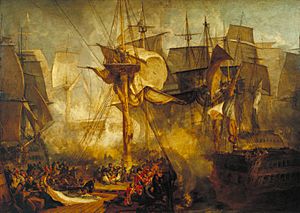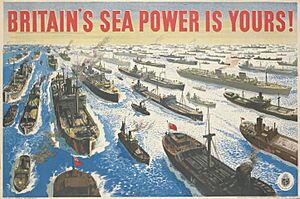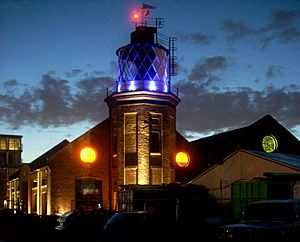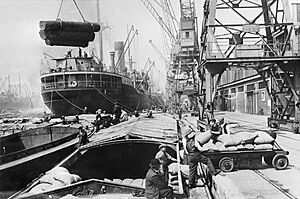Maritime history of the United Kingdom facts for kids
The maritime history of the United Kingdom is all about Britain's connection to the sea. It covers everything from shipping and ports to navigation and sailors. This history began when Great Britain became a united country in 1707.
Before planes and the Channel Tunnel, the only way to reach the British Isles was by sea. This is why sea trade and a strong navy have always been super important for Britain.
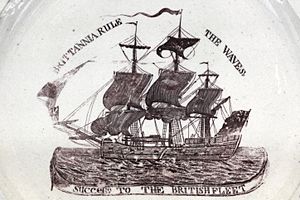
Contents
- A Timeline of Sea Adventures
- The Royal Navy: Protecting the Seas
- Famous Ships of British History
- Navigation: Finding the Way at Sea
- Safety and Rescue at Sea
- Ports and Harbours: Gateways to the World
- Trade: Connecting Britain to the World
- Ferries and Cruise Boats
- Fishing: A Vital Industry
- Energy from the Sea
- Coastline: Always Changing
- Fun on the Water: Leisure Activities
- Marine Science: Understanding the Oceans
- Maritime Studies: Learning About the Sea
- Maritime Museums: Preserving History
- Sea in the Arts: Art, Books, and Music
- Images for kids
A Timeline of Sea Adventures
The 1700s: New Beginnings
In the 1700s, Britain sold a lot of wool fabric and other goods to other countries.
Important groups like Lloyd's List (started 1734) and Lloyd's Register (1764/5) helped with shipping information. The The Marine Society (1756) helped poor boys become sailors.
People started trying out steam power for boats in the 1770s. An experimental steamship called the Kent was built in 1794, showing what was possible.
Towards the end of the century, the Napoleonic Wars began. These wars with Napoleon led to many big naval battles that continued into the 1800s.
The 1800s: Steam and Iron Ships
In 1801, a steamship called the Charlotte Dundas pulled barges on a canal near Glasgow. By the mid-1800s, steamships were common on British rivers and canals. Regular steamship trips across the Atlantic started in the 1830s.
Shipbuilders began using iron instead of wood. Iron ships could be made much larger and carry more cargo. Ships also got steam engines and paddle wheels, but paddles didn't work well in open seas.
From the 1840s, screw propellers replaced paddles. By the 1870s, new, more efficient engines meant that sailing ships slowly started to disappear. In the 1880s, steel began to replace iron for ship hulls.
Sailing ships, especially fast clippers, were still used for long journeys like carrying tea and wool. This was because steamships needed a lot of coal and large crews. But steamships gradually took over commercial shipping as their engines got better.
The Battle of Navarino in 1827 was the last time the Royal Navy fought only with sailing ships. By the end of the century, submarines and torpedoes were becoming useful weapons.
The 1900s: Big Ships and World Wars
At the start of the 1900s, a quarter of the world's trade went through British ports. Huge transatlantic liners competed to be the fastest. A famous event was the sinking of the Titanic in 1912. This disaster led to new safety rules like the Global Maritime Distress Safety System and the Iceberg Patrol.
Later, air travel reduced ocean travel, but by the end of the century, cruise ships became popular again.
New types of cargo ships appeared in the 1900s, like container ships, oil tankers, and gas carriers. Special ports were built to handle these huge ships.
Most warships used steam until gas turbines arrived in the middle of the century. Cargo ships switched from steam to diesel engines in the second half of the 1900s. Submarines used diesel and batteries until nuclear marine propulsion started in 1955.
Britain fought two major wars against Germany. These wars led to a huge growth in naval fleets and the use of air power at sea. Aircraft carriers became the most important warships. Both wars caused massive damage to Britain's merchant fleet, but new ships were built faster than they were lost. After World War II, the Cold War with the Soviet Union led to more new warships and submarines.
The early 2000s saw the building of giant superliners. The Royal Navy continued to get smaller, but new, larger aircraft carriers were planned.
When England and Scotland united in 1707, their navies joined to form the British Royal Navy. In the early 1700s, the Royal Navy had more ships than other navies. Even with money problems, new ways of funding the government and navy helped it become the most powerful force by the late 1700s. During the Napoleonic Wars, the Royal Navy was at its best, beating all of Britain's enemies.
A hospital for British sailors was founded at Greenwich by William III and Mary II.
Between 1793 and 1815, the Royal Navy lost many ships and sailors. Most losses were due to disease, accidents, or shipwrecks, not enemy attacks.
After the Battle of Trafalgar in 1805, Britain had almost total control of the world's oceans until 1914. People often said, "Britannia ruled the waves."
In the early 1900s, Jackie Fisher made big changes to the Navy. He got rid of many old ships to free up money and sailors for newer ones. He helped develop HMS Dreadnought, the first "all-big-gun" battleship. This ship was so advanced that it made all other battleships of its time old-fashioned.
During the First World War, the Royal Navy was crucial. It protected convoys of food, weapons, and materials coming to Britain. It stopped Germany's unrestricted submarine warfare and kept the German fleet trapped in port.
After World War I, the Royal Navy became much smaller due to treaties and money problems. But as tensions grew in the 1930s, Britain started building new warships again, including the King George V class battleships and several aircraft carriers.
After the Second World War, the British Empire declined, and Britain faced economic challenges. This led to the Royal Navy shrinking in size. The powerful United States Navy took over many of its global roles. However, the threat from the Soviet Union gave the Navy a new role within NATO.
The 1960s were a strong period for the Royal Navy after the war. Its fleet carriers, like Ark Royal, gave it the most powerful fleet outside the United States. It also had many frigates and destroyers. New, modern ships began to join the fleet. The Royal Navy also got its first nuclear weapons and became responsible for Britain's nuclear defense.
Later, a new government cut defense spending, and the Navy started to shrink. By 1979, the last large fleet carrier was gone. The Navy had to rely on smaller Invincible-class aircraft carriers with Sea Harrier jets.
Even though the Royal Navy is smaller now, its ships are much more advanced. It is responsible for Britain's nuclear defense and focuses on anti-submarine warfare and mine countermeasures as part of NATO.
Important Wars and Conflicts
American Wars
During the American Revolution, a simple submarine tried but failed to sink a British warship in New York City in 1776. John Paul Jones attacked British ships and towns. In the War of 1812, another submarine attack on a British warship failed.
French Revolutionary and Napoleonic Wars
In 1793, France declared war on Britain. The next 12 years saw many battles, like the Battle of the Nile. The Royal Navy's greatest achievement was on October 21, 1805, at the Battle of Trafalgar. A smaller but more experienced British fleet, led by Lord Horatio Nelson, completely defeated a combined French and Spanish fleet.
World War I at Sea
At the start of World War I, Germany had cruisers around the world that attacked Allied merchant ships. The Royal Navy hunted them down. The Battle of Jutland was the biggest sea battle of the war. Although the British fleet lost more ships, the German fleet retreated, and Britain kept control of the North Sea.
Britain also blocked Germany's ports, stopping supplies from getting in. German U-boats tried to cut supply lines between North America and Britain. These attacks often came without warning. After the sinking of the passenger ship RMS Lusitania in 1915, Germany promised not to target passenger liners.
In 1917, Germany started unrestricted submarine warfare again. The U-boat threat lessened when merchant ships began traveling in convoys, escorted by destroyers. This made it harder for U-boats to find targets. The First World War also saw the first use of aircraft carriers in battle.
World War II at Sea
In the North Atlantic, German U-boats again tried to cut supply lines to Britain. They sank many merchant ships. U-boats also attacked British warships, sinking the carrier Courageous and the battleship Royal Oak.
The British used ASDIC (an early form of sonar) to find U-boats. But Germans used "wolfpacks" that attacked on the surface at night. Britain eventually broke the German Naval code, which helped defeat this tactic.
The British sank the German cruiser Admiral Graf Spee in 1939 and the battleship Bismarck in 1941. However, the Royal Navy suffered heavy losses, including the battlecruiser Hood and the battleship Prince of Wales.
The Royal Navy played a critical role in the Dunkirk evacuation, rescuing many British and French troops.
Supply convoys were sent from Britain to the Soviet Union through the dangerous Arctic route. These convoys faced constant attacks from German U-boats, bombers, and surface ships.
Malta was an important base for attacking Axis supply lines to North Africa. Allied supply convoys to Malta faced fierce attacks, but eventually, the Allies won in North Africa. Gibraltar and Alexandria were also important naval bases.
In late 1941, Britain sent "Force Z" to deter Japanese aggression in the Far East. This force included Prince of Wales and Repulse. A day after the attack on Pearl Harbor, these ships were sunk by Japanese planes.
The "Second Battle of the Atlantic" turned in early 1943. The Allies improved their tactics and used new technology to fight U-boats. They built ships faster than they were sunk and used convoys more effectively.
For the D-Day landings in 1944, the Royal Navy provided most of the warships and landing craft. After Germany surrendered, a force was sent to the Pacific Ocean to fight Japan.
After World War II
From the 1950s to the 1970s, Britain had disputes with Iceland over fishing rights, known as the Cod Wars. These largely bloodless clashes involved British frigates and Icelandic gunboats. The dispute ended in 1976 when Britain recognized Iceland's 200-nautical-mile fishing zone.
The Falklands War was fought in 1982 between Britain and Argentina over the Falkland Islands. Britain sent a naval task force to retake the islands. The Royal Navy sank the Argentine submarine ARA Santa Fe and the cruiser ARA General Belgrano. However, Britain lost several destroyers and frigates to air attacks. The British eventually won, and the islands returned to British control.
The Royal Navy also took part in the 1990 Gulf War, the Kosovo War, the Afghanistan War, and the 2003 Iraq War. In 2005, the Royal Navy rescued seven Russians from a stranded submarine using a remote-controlled mini-sub.
Famous Ships of British History
Cutty Sark
The Cutty Sark is a famous clipper ship built in Scotland in 1869. She was designed to carry 600 tons of cargo. She raced other clippers in the tea trade from China and later in the wool trade from Australia. She could sail very fast, over 17 knots (31 km/h). After many years of trading, she was used as a training ship. Today, the Cutty Sark is a museum ship in Greenwich, London, and visitors can explore her.
Endeavour
HM Bark Endeavour was built in 1768 as a strong collier (coal ship). The Royal Navy bought her and used her for James Cook's first voyage to the Pacific Ocean. Her flat bottom was good for sailing in shallow water. She famously ran aground on the "Endeavour Reef" in the Great Barrier Reef but was repaired. After her return, she was sold and used as a merchant ship.
A replica of Endeavour was built in Australia and sailed to Whitby, England, where the original ship was built. It is now at the Australian National Maritime Museum in Sydney.
Great Britain
The SS Great Britain was designed by Isambard Kingdom Brunel. She was the first large iron steamship and the first to use a screw propeller. She made the first regular steamship crossings of the Atlantic. After a long career, she was abandoned in the Falkland Islands. But she was brought back to the drydock in Bristol where she was built and has been beautifully restored.
Great Eastern
The SS Great Eastern was launched in 1858 and was six times bigger than any ship before her. She was also designed by Brunel. She had six masts and coal-fired engines that drove paddle wheels. She was meant to carry 4,000 passengers (or 10,000 soldiers) and enough coal to travel to Australia and back. Building and launching her was very difficult.
After some problems, she was used for Atlantic crossings. Passengers didn't like how she rolled in storms, so she was sold to a company that laid underwater cables. The Great Eastern laid the first transatlantic telegraph cable and many others. She was broken up in 1888.
Titanic
The Titanic was built by the White Star Line to be bigger and more luxurious than any other ship. She was 269 meters long and weighed 45,000 tons. She was called a "luxury hotel at sea" and "unsinkable." She had a double bottom and 16 watertight compartments.
Titanic left Southampton on April 10, 1912, for her first trip to America. Despite warnings of icebergs, she continued at high speed. Around midnight on April 14, she hit an iceberg, and five compartments flooded. Two hours later, she sank. There were only enough lifeboats for half the people, and about 1,500 lives were lost. Her wreck was found in 1985, 4,000 meters deep, and explored using a remotely operated vehicle (ROV).
Queen Mary
RMS Queen Mary was built in 1936 for the Cunard Line. She made regular trips across the Atlantic between Southampton, Cherbourg, and New York City. During World War II, the Queen Mary was used as a troop ship, carrying many soldiers. After the war, she went back to Atlantic trips but eventually stopped. Since 1967, she has been a hotel and tourist attraction in Long Beach, California.
Britannia
HMY Britannia was the royal yacht of the British royal family. The last one was built in 1953 and served for nearly 43 years, traveling 71 million miles. She was designed to be a hospital ship in wartime, but she never had to do that. Today, she is preserved in Leith, Scotland, as a visitor attraction.
Victory
HMS Victory was built between 1759 and 1765 with over 100 guns. She fought in several battles, including Cape St. Vincent in 1796. She was rebuilt in 1798 with more guns and famously fought at the Battle of Trafalgar in 1805, where Lord Nelson died on board. Victory is now in drydock at HMNB Portsmouth (Portsmouth Historic Dockyard) and is still the flagship of the Second Sea Lord.
Warrior
HMS Warrior was built in 1860 as a response to a French ship. She was the first iron-hulled ironclad warship, with three layers of iron and teak. She was described as a "black snake amongst the rabbits" by Napoleon III. Her construction started a revolution in shipbuilding. After her service, she was restored and is now on display at HMNB Portsmouth.
Belfast
HMS Belfast is a Town-class cruiser launched in 1938. At the start of World War II, she helped block Germany. After being damaged by a mine, she was rebuilt and became the heaviest cruiser of her type. Belfast fought in the Battle of North Cape and took part in the D-Day landings. She also served in the Korean War. Today, Belfast is a museum ship on the River Thames in London.
Tools and Guides
Between 1735 and 1760, John Harrison developed special marine chronometers. These clocks were very accurate at sea, helping sailors figure out their exact longitude (east-west position).
The gyrocompass was introduced in 1908, providing a stable direction reference.
Lighthouses
The first offshore lighthouse was built on the Eddystone Rocks in 1699. It was later washed away, but replacements were built. The third lighthouse on the reef still stands. The first lightship (a ship that acts as a lighthouse) was placed at the Nore in 1732. Foghorns were added in the 1800s to warn ships in bad visibility.
Trinity House was founded in 1514 to look after navigation marks (like buoys and beacons) in the Thames Estuary. Later, other similar groups were formed and then combined. Trinity House now looks after most marks in England and Wales.
Ship's radar started being used during World War II for military purposes. After 1945, it became available for commercial ships. Radar is also used on land to monitor shipping, especially in busy areas like the Strait of Dover.
The Decca Navigator System was a radio navigation system used by commercial ships after World War II. It was very accurate and helped ships find their way until GPS satellite systems became available in 2001.
Electronic echo sounding was introduced in the 1930s to measure water depth, which was very helpful in shallow areas.
Safety and Rescue at Sea

The Plimsoll Line
In the 1800s, some ship owners would overload old, poorly maintained ships, hoping to get insurance money if they sank. These were called "coffin ships." Samuel Plimsoll fought against this. The Merchant Shipping Act of 1876 required a load line (now known as the Plimsoll Line) on ships. This line shows how much cargo a ship can safely carry.
Lifeboats
Some local lifeboat groups existed in the 1700s. The Royal National Lifeboat Institution (RNLI) was founded in 1824 and is funded by donations. It has many lifeboats and stations around Britain's coast, mostly run by volunteers. Early boats used oars, then steam, and now large diesel-driven boats and fast inshore boats. Hovercraft are also used for rescues in some places. The RNLI works with other rescue services, like helicopters.
Maritime and Coastguard Agency
The Maritime and Coastguard Agency (MCA) was formed in 1998 to ensure safety in British waters. It coordinates search and rescue services and sets safety standards for ships.
Ports and Harbours: Gateways to the World
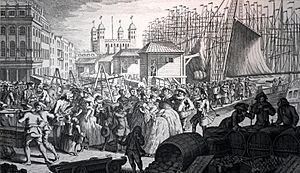
Britain has hundreds of ports and harbours, from tiny ones to huge ones like the Port of Felixstowe. Over time, the importance of ports changed due to things like silting or new trade routes. Deep water access became very important for a port's success.
In the 1700s, many harbours were improved with dredging and new piers. Wet docks (enclosed docks where ships float at all tides) were built in London, Liverpool, Hull, and Bristol.
London was the largest port in the 1800s, with new docks being built. Cardiff became a major coal exporting port after a railway link was built. Railways also helped develop new ports like Newhaven for ferry terminals. The Manchester Ship Canal allowed Manchester to become a significant port even though it was far inland.
When oil replaced coal after World War I, coal ports like Cardiff declined. After World War II, new ways of handling cargo were introduced, like pallets, containerisation, and roll-on/roll-off ships. Some dock workers resisted these changes, leading to new facilities being built at ports like Felixstowe and Tilbury.
Older port facilities were no longer needed and were redeveloped, like Canary Wharf in London. Many small ports were turned into marinas for leisure boats.
Trade: Connecting Britain to the World
Goods and Global Trade
The Navigation Ordinance of 1651 stopped Dutch ships from trading with England, which led to war. In the 1600s, trade grew with imports of fish and sugar, and exports of corn and manufactured goods.
A major part of trade later became the "Triangular trade." This involved taking goods from Britain to West Africa, then slaves from Africa to the West Indies and America, and finally sugar back to Britain. Main ports involved were London, Bristol, and Liverpool. The slave trade was abolished in 1808, and the Royal Navy tried to stop it.
The Industrial Revolution caused a huge increase in shipping. Raw materials were imported, and manufactured goods were exported. Britain built the largest merchant fleet in the world in the 1800s. About half of all ocean-going ships flew the British flag.
In World War I, a fifth of Britain's merchant ships were sunk by 1917. Most deep-water ships were sunk by torpedoes, and coastal ones hit mines. After the war, there was a slump in shipping. Refrigerated ships allowed lamb and other meats to be imported from places like New Zealand. Many merchant ships were sunk in World War II, but Britain's fleet grew by the end of the war due to new construction.
Britain still had the world's largest merchant fleet in 1957 (excluding tankers). However, it has sharply declined since then, partly because ships now often register in other countries to save costs. Today, Britain is the world's fifth-largest trading nation, and 95% of its trade goes by sea.
Passenger Liners
The first paddle steamer was used in 1793. By 1821, there were services between Leith and London. The first British steamer to cross the Atlantic was the Sirius in 1838. Companies like "P&O" and the "White Star Line" (which built the Titanic) became famous for passenger travel. During wartime, these liners were used as troop ships. Southampton became the main passenger port because of its deep harbour.
Emigration and Deportation
Many people left Britain to live in North America. After losing the American Colonies, Britain used Australia as a penal colony (a place to send convicts). The First Fleet in 1787 carried 1,200 people, including 780 convicts. After World War II, many emigrants traveled by sea to the US, Canada, Australia, and New Zealand.
Ferries and Cruise Boats
Ferries operate across the English Channel, the Irish Sea, and to many islands around Britain. Regular ferry services started in the 1700s. The ferry trade grew with roll-on/roll-off ship designs. The opening of the Channel Tunnel in 1994 greatly affected ferries across the English Channel.
Cruise boats became popular in the 1800s, offering trips from beaches and rivers. The paddle steamer Waverley, built in 1946, is still running today, offering trips to places like Lundy.
Fishing: A Vital Industry
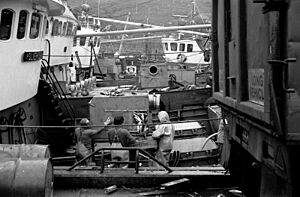
In the 1800s and early 1900s, herring fishing was a major activity in Britain. Herring fishing stopped in England and Wales in the 1960s.
Trawling (fishing with a large net dragged behind a boat) has also been important. Fishing in waters off Iceland led to three "Cod Wars" from the 1950s to the 1970s. British boats were excluded from Icelandic waters in 1976. In 1977, a 200-mile (320 km) fishing limit was set up by the European Economic Community, which opened British waters to other European countries. This led to overfishing.
Other types of commercial fishing include crab, lobster, shellfish, and mackerel. Sport fishing is also popular.
In the past, different areas had different types of fishing boats. Steam trawlers were introduced in 1881. By 1890, an estimated 20,000 men worked in the North Sea fishing industry.
Energy from the Sea
Gas and Oil
The first British oil tanker was launched in 1886. Tankers grew much larger over time, reaching over 250,000 tons by 1973.
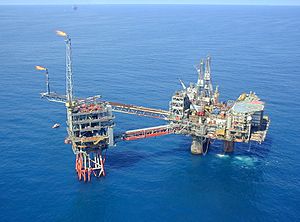
Gas fields in the North Sea have been producing since the 1960s, and oil was discovered off Scotland in 1975. This led to the development of support bases in Scotland. The decline of North Sea gas has led to the construction of liquid gas tankers and import facilities.
Oil Spills
There have been several major oil spills around Britain's coast. The wreck of the Torrey Canyon in 1967 caused the first major oil spill. The ship grounded between Cornwall and the Isles of Scilly. This led to many lessons learned about handling such problems and changes in regulations. Other spills, like the MV Braer in 1993 and the Sea Empress in 1996, also caused significant environmental damage and led to further improvements in safety.
Offshore Wind Farms
Britain started installing wind farms off shore in 2000. By 2007, they could produce 2 GW of power, providing up to 1.5% of the UK's electricity. The capacity of offshore wind farms is expected to grow much more in the future.
Coastline: Always Changing
The coastline of the United Kingdom is constantly changing due to erosion and deposition. Areas like the east coast of England suffer from major erosion. For example, the town of Dunwich, once a large port, has been swallowed by the sea. Many beaches have groynes (structures built to control sand movement) to protect them.
Some areas of the UK are now threatened by rising sea levels. In the past, the North Sea, Bristol Channel, and English Channel have been flooded. The land is also still recovering from the last ice age, so southern England is sinking while Scotland is rising. The Thames Barrier was completed in 1994 to prevent flooding in the upper Thames estuary.
Fun on the Water: Leisure Activities
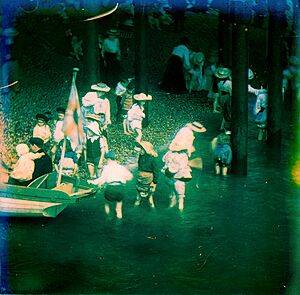
Seaside Resorts
In the 1700s, people started visiting British coasts for fun. Initially, it was for health reasons, but it became popular when King George III made Weymouth his summer home around 1800. Many resorts like Blackpool became popular when railways connected them to big cities. More recently, British resorts have become less popular due to cheap package holidays abroad with better weather.
Boating and Racing
Offshore rowing races are popular in southwest England using gigs. These are six-oared boats, about 10 meters long.
Yacht clubs became popular, and many different dinghy designs emerged. Large yachts, like the J-class, were built to compete in races like the America's Cup. Cowes Week has been held since 1826 and includes a race around the Isle of Wight. The Fastnet race started in 1925. Famous single-handed sailors like Francis Chichester and Robin Knox-Johnston completed amazing voyages around the world.
Frederick W. Lanchester built the first power boat in 1898. Since then, power boats have been used for fun, racing, and water-skiing. The British Power Boat Company built many power boats, including those that became the basis for Motor Torpedo Boats in World War II.
Marinas
The growing popularity of yachting and power boating has led to the creation of many special marinas and the conversion of existing harbours to hold leisure boats.
Marine Science: Understanding the Oceans
Mapping the Seas
The United Kingdom Hydrographic Office is responsible for publishing nautical charts (sea maps) for Britain and worldwide. It was set up in 1795. One of its main goals was to find a Northwest Passage around Canada.
Oceanography
James Cook included information on the oceans in his voyage reports (1768-1779). James Rennell wrote early textbooks about ocean currents. Sir James Clark Ross took the first deep-sea sounding in 1840. The Royal Society sponsored the Challenger (1858) expedition (1872–76), which produced a huge report on ocean biology, physics, and geology.
The National Oceanographic Centre operates vessels and unmanned vehicles to explore the oceans.
Maritime Studies: Learning About the Sea
Colleges
Many places in the UK offer courses to study different aspects of seamanship, like Orkney College. These courses can lead to certificates for specific jobs. Other places, like Liverpool John Moores University, offer more academic courses on ship design and how ships operate. The University of Exeter specializes in maritime history.
Ship Design
Originally, ship design was done by skilled shipwrights. A school of naval architecture was set up at Portsmouth in 1811. Today, ship design can be studied at many colleges in Britain. The Royal Institution of Naval Architects is the professional group for ship designers in Britain.
Maritime Museums: Preserving History
The main maritime museum in Britain is the National Maritime Museum at Greenwich. But there are almost 300 smaller museums (including ships) at various ports around Britain. These include museums in Kingston upon Hull, Hartlepool, and the Merseyside Maritime Museum in Liverpool. They offer a lot of information about Britain's sea history.
Maritime Archaeology
Maritime archaeology is important in Britain because of the many shipwrecks around the coast and large areas that have been covered by rising sea levels. Archaeologists study shipwrecks from the Bronze Age onwards. Many old items have been found in the southern North Sea. The subject can be studied at universities in Bristol, Bournemouth, and Southampton.
Sea in the Arts: Art, Books, and Music
Art
Many beautiful works of Marine art have been created by British artists, showing British ships and sea scenes. One of the most famous paintings is "The Fighting Temeraire" by J. M. W. Turner, which is in London's National Gallery. Many seaside towns have art galleries selling marine art.
Sailors themselves also created art, like scrimshaw (carvings on whalebone or ivory).
Literature
Britain has many authors who wrote about the sea, especially about the sailing era. Joseph Conrad, born in Poland, became a British citizen and wrote many stories based on his experiences at sea, like "Lord Jim". Basil Lubbock and Alan Villiers also wrote books about sailing ships and the life of sailors. Many famous fiction books have been written, like the "Horatio Hornblower" series by C. S. Forester.
Music
There are many traditional sea shanties (songs sung by sailors while working) that have been collected, often from places like Watchet.
Images for kids
-
Beatty's flagship HMS Lion burning after being hit by a salvo from SMS Lützow.
-
Cook's landing at Botany Bay in 1770.
-
Cunard-White Star RMS Queen Mary baggage tag.
-
Legal Quays (Pool of London) in 1757.
-
Unloading fish on the fishing boat "Silvery Sea" in Mallaig harbour, Scotland, in 1977.
-
Three-colour lantern slide of children playing on a Brighton beach, 6 August 1906.


